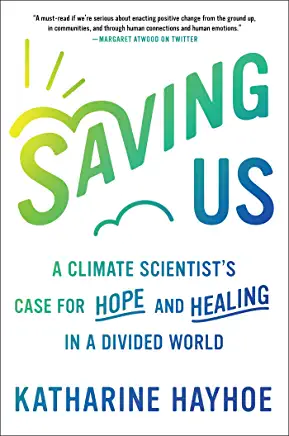
Saving Us
Katharine Hayhoe is an eminent climate scientist who teaches at Texas Tech which means that she lives in the heart of fossil fuel country.
She is also an evangelical Christian. Her husband is a pastor.
In other words she lives in the midst of political conflict about the topic she has dedicated her professional life to on a daily basis.
She knows that climate change is real. She also knows that many of those who share her religious beliefs deny the importance of the research she and her colleagues have done.
She also lives smack dab in the middle of the culture wars ravaging our country. They affect her personally.
So, she decided to write Saving Us which has less to do with her professional expertise and more to do with how we have conversations about climate with people we disagree with.
As she notes early on, the debate is rarely over the science these days. No more than about ten percent of the American public could still be classified as climate change deniers. At the same time, only about ten percent of the public can be seen as ardent activists or even voters who want to change our public policies.
If she (and we) want to save the planet, she suggests, we have to reach out to the vast majority of people who are in the middle. We have to goad people who agree about the science but aren’t doing anything about it into action. More importantly, we have to reach out to the roughly half of the population that is skeptical, either about some of the science or the fact that climate change affects their lives.
Therein lies the value of Saving Us which every Peacebuilders should read for that reason. As she says on p. 10, don’t try to convince them that they are wrong using evidence from Greta Thunberg or Al Gore. Rather,
Start with something you have in common. Connect it to why climate change to us personally—not the human race in its entirety or the Earth itself, but rather us as individuals. Climate change affects nearly everything we already care about.
The bulk of the book is devoted to tools we can use to broaden support for policies that would slow down the rate of change. I won’t go into them in detail here because they will be familiar to most peacebuilders. And, you should read the book, because it is so powerful.
- start with what you agree about and care about together
- don’t point fingers at the other side
- connect climate change to the lived experience of the people you talk with (e.g., Texas ranchers who are suffering through a prolonged drought)
- listen to their point of view and treat them with respect
- suggest things that they can do in the stride of their everyday lives that both help stop climate change and are consistent with their other (often conservative) values
- show ways that adopting solar or wind power can improve everyone’s lives, provide new jobs, and protect our current standard of living
- help them see that climate change is making problems we already fact worse and will continue to do so for generations to come if we don’t act now and that doing something about it now can have second and third order effects that lead to improvements in other aspects of our lives
